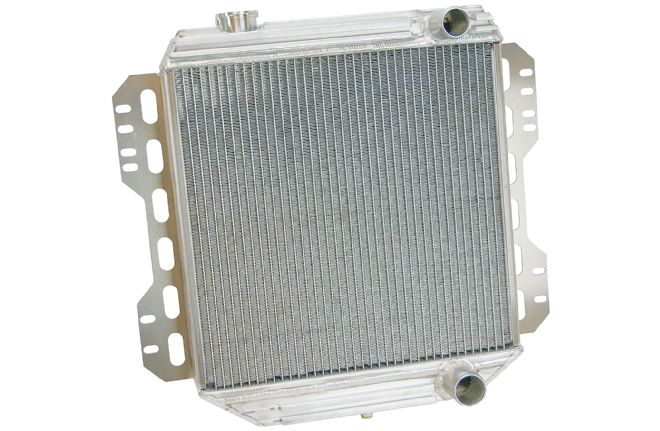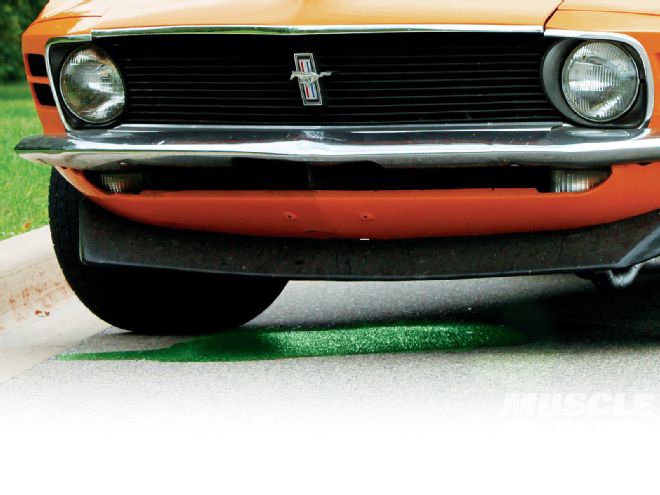
Editor’s note: We’re taking a two-pronged approach to cooling system tech in this issue. To illustrate the hands-on side of things, Wayne Scraba photographed the components he used to restore the cooling system in his Nova, originally a small-block–equipped car that will eventually be a big-block–powered, day-two muscle car. Taking a more theoretical approach, Drew Hardin polled several aftermarket companies that specialize in cooling systems to get their tips and advice on how to keep a muscle car at proper operating temperature.
In mapping out the upgrade for our Nova’s cooling system, we wanted to keep the beast cool while not straying too far from the factory look. Where do you find a radiator that looks right? The same question applied to all sorts of detail parts, including the radiator support, water pump, and even items like the radiator hoses, hose clamps, and other little hardware.
A number of vendors out there go out of their way to provide decidedly accurate, top-quality reproduction pieces. A case in point is the cross-section of cooling system parts we rounded up for this article. You might be surprised at what’s out there. You can even locate hardware that is appropriately date coded. And maybe best of all, you don’t have to reach your personal boiling point when searching for these components.
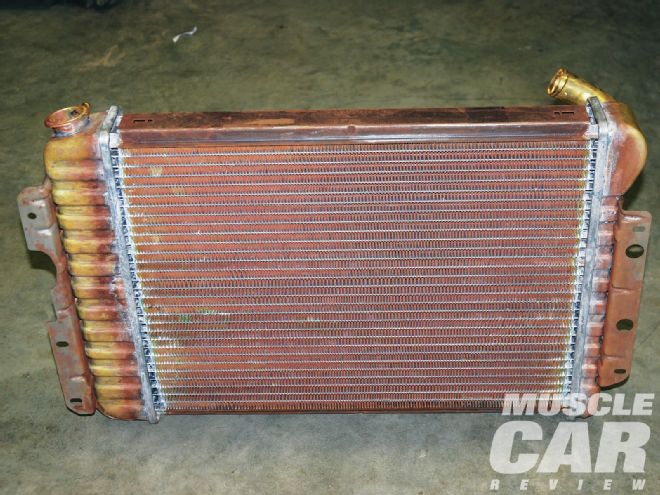 Today, vintage Harrison radiators are next to impossible to find, but you can buy a perfect made-in-the-USA reproduction from Classic Industries. As you can see, the radiator comes unpainted. Following manufacture, the radiator will see rapid surface rusting. It’s not a big issue though. Classic Industries simply recommends you glass-bead the tanks and then paint the assembly with radiator paint.
Today, vintage Harrison radiators are next to impossible to find, but you can buy a perfect made-in-the-USA reproduction from Classic Industries. As you can see, the radiator comes unpainted. Following manufacture, the radiator will see rapid surface rusting. It’s not a big issue though. Classic Industries simply recommends you glass-bead the tanks and then paint the assembly with radiator paint.
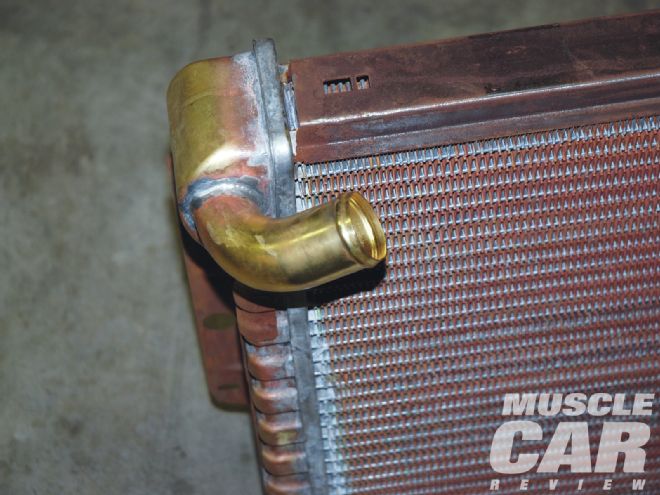
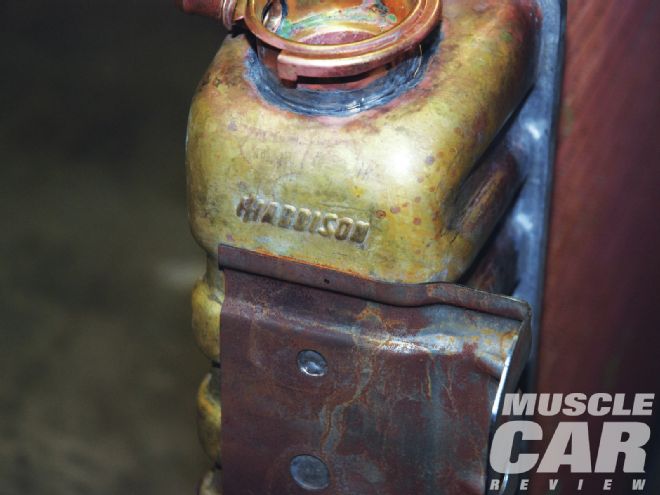 The tanks and mounting brackets are exact copies of the original. This is a four-core, heavy-duty radiator for a Camaro or Nova. You can see the Harrison logo is accurately reproduced on the side tank. Also note the gooseneck inlet at the top of the radiator. Very late big-block Novas, circa 1969, could in fact have a gooseneck radiator, just like a COPO Camaro.
The tanks and mounting brackets are exact copies of the original. This is a four-core, heavy-duty radiator for a Camaro or Nova. You can see the Harrison logo is accurately reproduced on the side tank. Also note the gooseneck inlet at the top of the radiator. Very late big-block Novas, circa 1969, could in fact have a gooseneck radiator, just like a COPO Camaro.
The lower hose required for our application came from Pacecar Jeff. Jeff’s hoses are exact replacements, and they include internal reinforcements as per the originals.
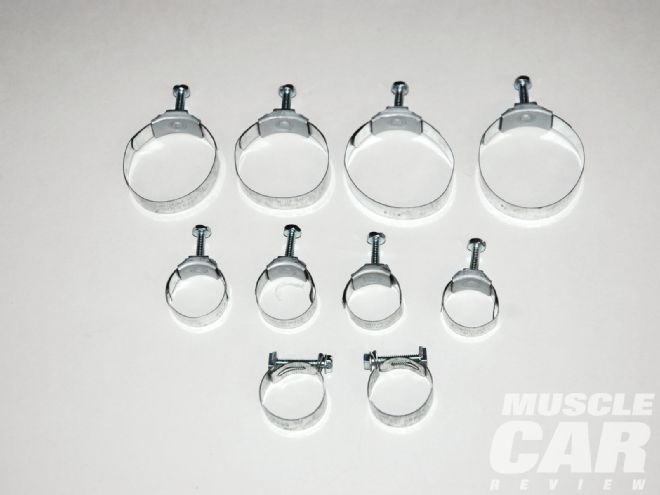 Check out these Witteck hose clamps from Pacecar Jeff, which are date stamped. You simply have to request an appropriate date code, and Jeff will stamp it for you.
Check out these Witteck hose clamps from Pacecar Jeff, which are date stamped. You simply have to request an appropriate date code, and Jeff will stamp it for you.
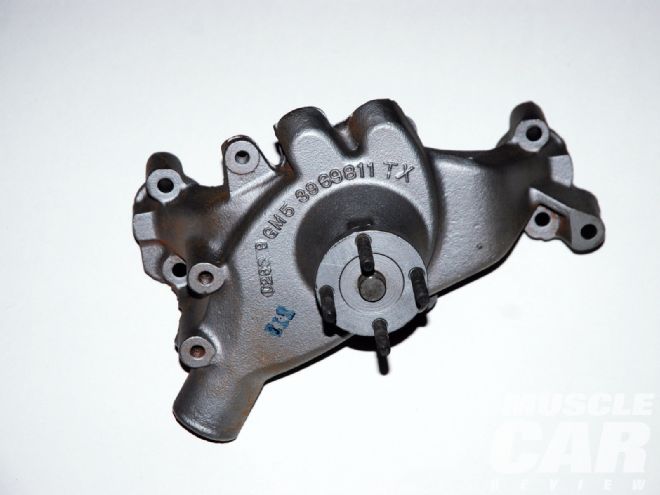 A big part of the cooling system in any restoration is the water pump. Chevyphiles are fortunate in that correct-part-number and appropriate-date-coded water pumps for many applications are readily available. The “3969811” casting number is appropriate for a wide range of ’69 and later “long-pump” big-blocks (Chevelles, Camaros, Novas, and Impalas).
A big part of the cooling system in any restoration is the water pump. Chevyphiles are fortunate in that correct-part-number and appropriate-date-coded water pumps for many applications are readily available. The “3969811” casting number is appropriate for a wide range of ’69 and later “long-pump” big-blocks (Chevelles, Camaros, Novas, and Impalas).
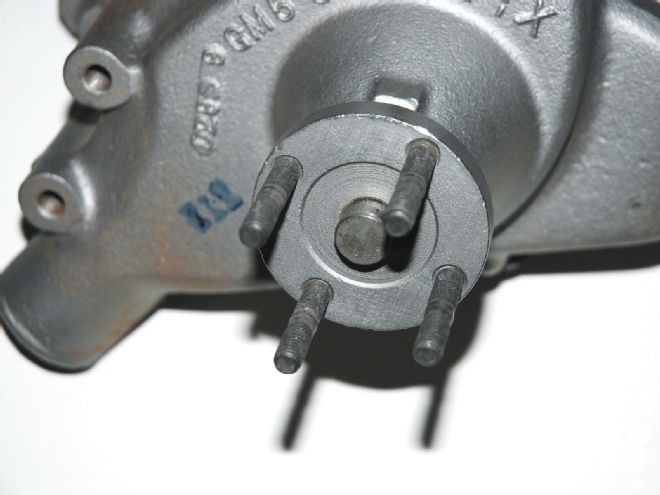 Up front, the pump is fitted with the appropriate pulley and fan studs. Both the pump and the studs are available from Classic Industries.
Up front, the pump is fitted with the appropriate pulley and fan studs. Both the pump and the studs are available from Classic Industries.
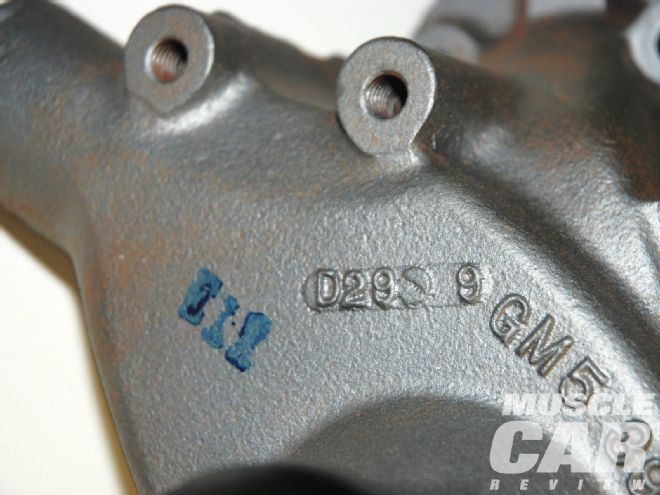 The date code for this big-block water pump is D-29-9, which decodes as April (“D”) 29, 1969.
The date code for this big-block water pump is D-29-9, which decodes as April (“D”) 29, 1969.
To learn more about the theory behind cooling system upgrades, we spoke with Greg Lovell of Be Cool, Lisa Chissus of Flex-a-lite, and Lee Chamberlain of The Brassworks/FlowKooler. We’ve excerpted a few of their comments here. You can dive deeper by visiting the manufacturers’ websites, as all of them have FAQ sections with detailed information about cooling in general as well as their specific products. FlowKooler’s FAQ section, in particular, is an outstanding resource.
MCR: What’s the single most important component in the cooling system?
Lovell: While each component—radiator, water pump, hoses, fan(s), and even the water passages in the block and heads—plays an important role in the overall effectiveness of a cooling system, the key to optimum cooling is maximizing the square inches of radiator core for any given application.
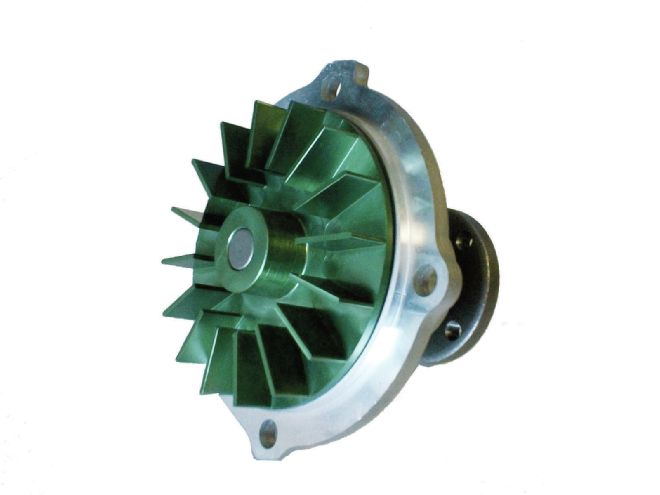 FlowKooler recently upgraded its aluminum water pump for big-block Chrysler and Dodge applications with a 16-blade, CNC-machined aluminum impeller. With the increased vane count and a reduction in the impeller-casting clearance, the new pump can achieve greater flow rates, higher head pressure, and a more efficient flow, says the company.
FlowKooler recently upgraded its aluminum water pump for big-block Chrysler and Dodge applications with a 16-blade, CNC-machined aluminum impeller. With the increased vane count and a reduction in the impeller-casting clearance, the new pump can achieve greater flow rates, higher head pressure, and a more efficient flow, says the company.
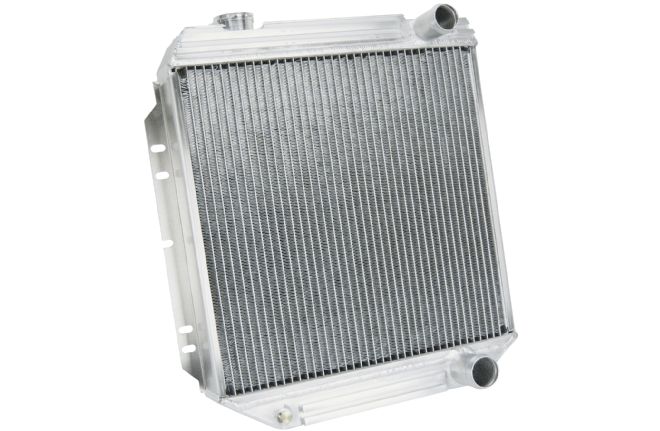 Flex-a-lite manufactures radiators and radiator/fan combination kits for a number of muscle car applications. The latest are these radiators for ’64-’66 Mustangs. The company has radiators for ’67-’69 Mustangs too, as well as first- and second-gen Camaros and vintage Corvettes.
Flex-a-lite manufactures radiators and radiator/fan combination kits for a number of muscle car applications. The latest are these radiators for ’64-’66 Mustangs. The company has radiators for ’67-’69 Mustangs too, as well as first- and second-gen Camaros and vintage Corvettes.
MCR: Can you upgrade a cooling system piece by piece, or should it be upgraded as a whole?
Lovell: Changing the radiator alone—from an OE copper/brass/lead single-core to an aftermarket aluminum dual-core—will lower running temperatures 10 degrees or more, depending on the application. Adding a high-torque electric fan will reduce temps another 10 degrees on average. Shrouded fans and/or dual fans will lower temps even more. A high-flow or high-volume water pump will maximize efficiency and complete a total cooling package. So yes, you can upgrade the system piece by piece, although it is generally more convenient and cost-effective to do it all at one time.
Chamberlain: If you are chasing an overheating issue, try to isolate the cause, change that part, and then evaluate the results. A complete overhaul may give you peace of mind, but we see people replace whole radiators when the problem is as simple as a stuck thermostat.
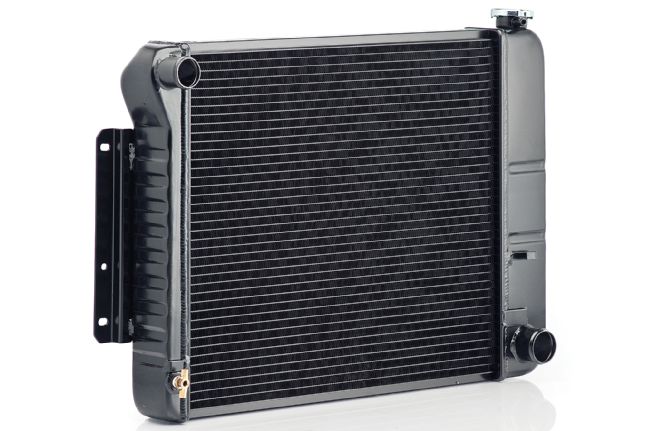 Be Cool offers these all-aluminum OE-style replacement radiators with dual 1-inch cores and a stock-looking black finish. All Be Cool radiators are made in the USA.
Be Cool offers these all-aluminum OE-style replacement radiators with dual 1-inch cores and a stock-looking black finish. All Be Cool radiators are made in the USA.
MCR: When shopping for a replacement radiator, what should a buyer look for?
Lovell: Most aftermarket performance radiators are made from aluminum with dual 1-inch cores and fabricated aluminum tanks, providing increased radiator core surface area and a 40-percent weight savings over OE units. Important features to consider include fully welded epoxy-free construction; billet aluminum filler neck with high-capacity overflow tube; OE-size inlet and outlet; direct-fit applications; provisions for flange, cradle, pin, or foot mounting (depending on application); heavy-duty (seven-plate) internal automatic transmission coolers and fittings; OE brass drain petcock; warranty.
Chissus: Be sure to maximize the length and width of the radiator to the space you are trying to cool. Keep in mind if you are going to a beltdriven fan, you need to make sure you are leaving proper clearance between the surface of the radiator and the edge of the fan blade. You need 1 inch of clearance for a flex fan and at least a half-inch for a rigid fan blade, as you can get engine movement that can put the blade spinning into your radiator core. Also, an aluminum side tank will dissipate heat better than a stock composite tank. Flex-a-lite’s extruded side tank design adds additional surface area for 104-percent better heat dissipation than a stock tank design.
Chamberlain: The BTU transfer rate of aluminum is half that of copper. It is more susceptible to electrolysis and harder to repair. Copper is a faster heat exchanger, less prone to electrolytic corrosion, and can be repaired. Copper radiators generally require more labor to construct and, if done properly, will have no perceptible solder line. With either material, a good core design and construction are as important as the material. Variables such as tube design, layout, coolant capacity, core face area, core thickness, fin surface and density, and total heat exchange surface area are important considerations.
MCR:What options are available to the muscle car owner who wants to retain a stock look to his radiator/cooling system?
Lovell: Be Cool offers an all-aluminum OE Series radiator with stamped tanks that offers the appearance of an OE-style copper/brass/lead radiator while providing maximum cooling performance of a modern radiator.
Chamberlain: Copper and brass radiators from this period are frequently restored using the original tanks and period-correct core designs or more modern and efficient core designs. Water pumps can be rebuilt with new bearing seals and better impeller systems. Having an aluminum radiator when it should be copper is like wearing dirty underwear. No one else may know you have it on, but you sure do. If you want factory correct, buy a copper radiator.
MCR: What are the benefits of upgrading to an electric fan versus the stock mechanical fan?
Lovell: High-torque electric fans provide powerful, consistent cooling airflow regardless of engine rpm, compared to a stock engine-driven fan, which is limited by engine rpm. At slow driving speeds, such as cruising, a parade, or stop-and-go traffic, an engine-driven fan is producing the least amount of airflow when you actually require maximum cooling airflow. Electric fans provide increased cooling at low speeds and allow the removal of the stock engine-driven fan, resulting in a significant horsepower gain and fuel savings.
Chissus: The electric fan frees up horsepower by taking the drag off of the engine. It also gives quicker engine warm-ups, extends the life of the water pump, provides cooler A/C output at idle, and will improve the gas mileage—unless you have your foot in the floor to the feel the added torque!
MCR: How important is a fan shroud to the cooling system?
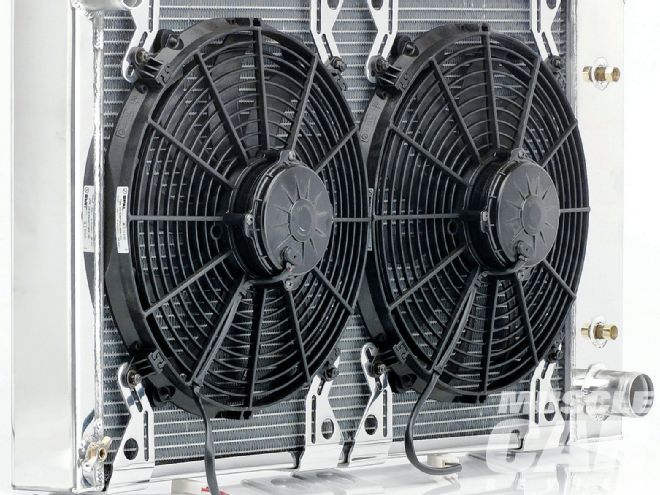 Electric fans, like this pair from Be Cool, provide maximum airflow even at low engine speeds, yet they don’t create the parasitic power loss that occurs with engine-driven fans.
Electric fans, like this pair from Be Cool, provide maximum airflow even at low engine speeds, yet they don’t create the parasitic power loss that occurs with engine-driven fans.
Lovell: Shrouds are designed to funnel the airflow through the radiator core and provide a huge benefit for engine-driven fans. Shrouds also improve the performance of electric puller fans as long as there are relief chambers in the shroud to exit trapped air at highway speeds. Do not shroud a pusher fan mounted in front of the radiator, as this will only obstruct air flow.
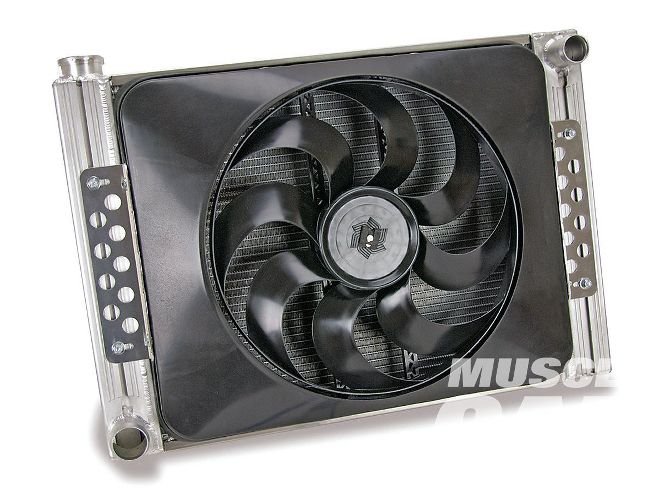 This first-gen Camaro radiator/fan combo shows the extruded side tanks included with Flex-a-lite radiators.
This first-gen Camaro radiator/fan combo shows the extruded side tanks included with Flex-a-lite radiators.
Chissus: There’s also a safety factor. You don’t want to drop a tool into a spinning fan blade or suck up a rock and have it come flying. It also provides better cooling by making sure the air gets pulled through the radiator rather than sucking from the engine compartment. You need 1 inch of clearance from the tip of the fan blade to your shroud.
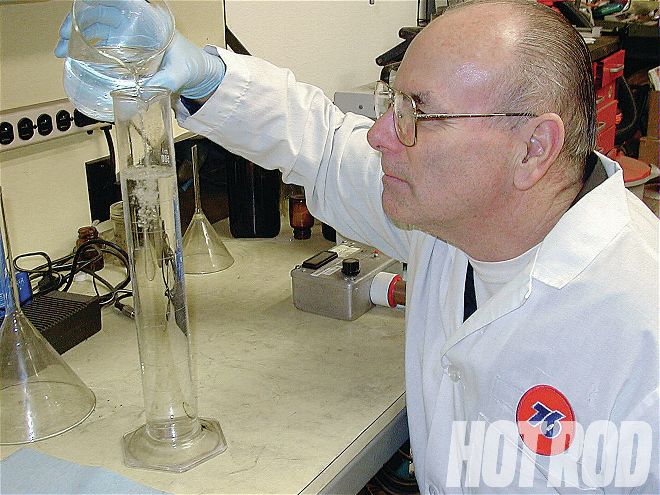 The Brassworks specializes in reproducing, restoring, and custom-building high-quality radiators for vintage cars and hot rods. This fully shrouded radiator/fan combo (for a T-bucket street rod) is made from a German silver alloy, not polished aluminum or chrome.
The Brassworks specializes in reproducing, restoring, and custom-building high-quality radiators for vintage cars and hot rods. This fully shrouded radiator/fan combo (for a T-bucket street rod) is made from a German silver alloy, not polished aluminum or chrome.
MCR: When shopping for a replacement water pump, what should a buyer be looking for? Material type, construction, size, features?
Chamberlain: Impellers with tighter clearance between the impeller vane and the casting, and the vane and backing plate, are preferred. Well-designed efficient vanes will generate higher flow rates, which reduces the cycle time between the source and sink and helps to raise system pressure. Roller bearings and well-constructed seals help preserve bearings from premature failure. FlowKooler uses a military grade Type II anodized finish on its precision-machined aluminum impeller systems to prevent corrosion.
MCR: Any other advice or tips for owners of ’60s or ’70s high-performance cars?
Chissus: Make sure your cooling products are quality made. There are lookalikes out there that do not provide the cooling you will need.
Chamberlain: Maintain your fluids, get the air through the radiator core and out, get a good high-flow water pump, and check your timing. Retarded timing contributes to overheating. Advanced timing helps cooling. Advance your initial timing a few degrees and see if it helps the car run cooler. However, if you advance too much you risk detonation, and that too will cause you to overheat.
